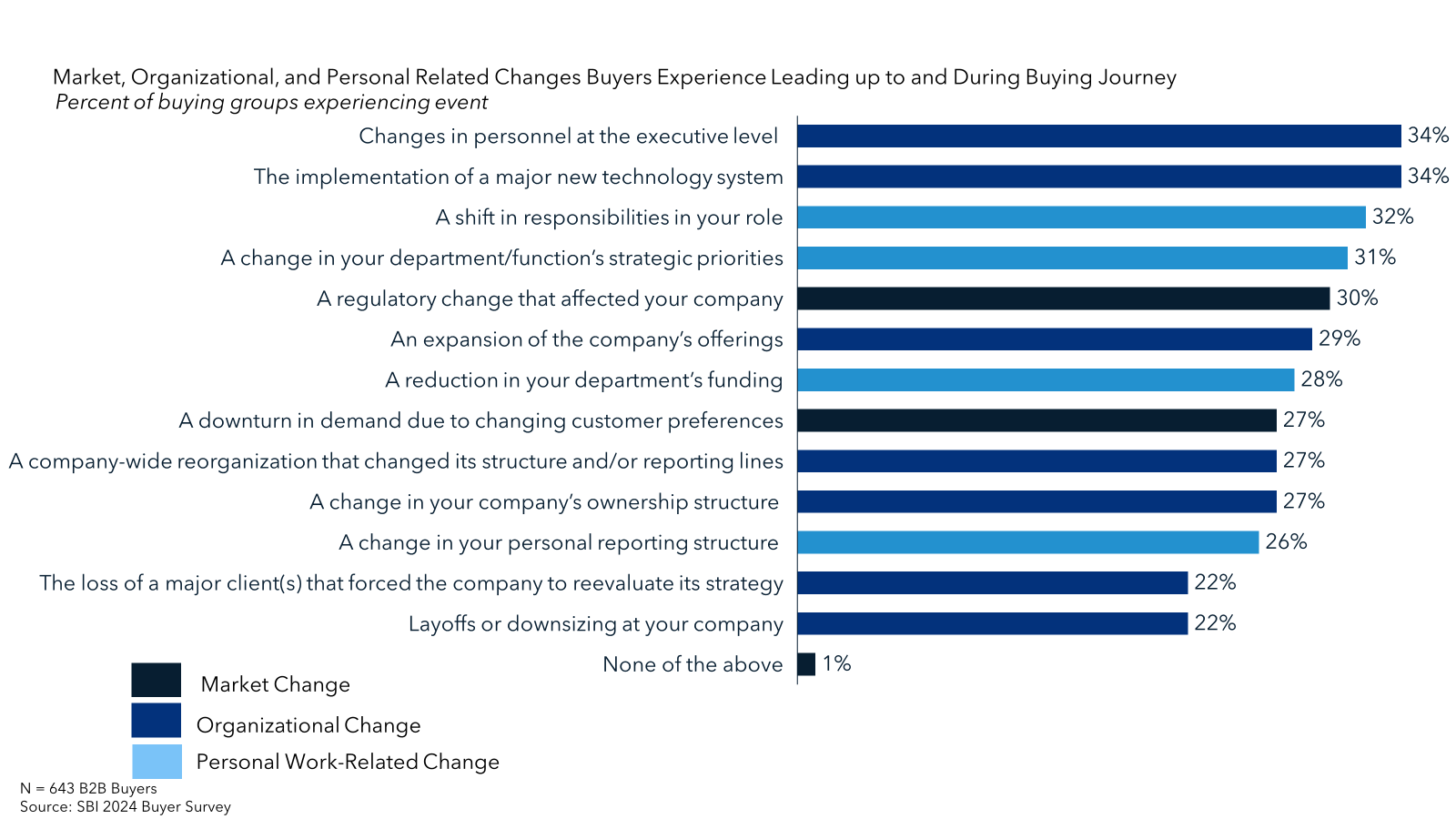Buyers today face a lack of consistency: from rapidly shifting priorities to uncertain regulatory environments, every step in the purchasing journey is plagued with second-guessing and hesitation. The main issue for commercial teams? Reset buying, where just as everyone in the buyer decision team gets agreement, changes happen and reset the progress that sellers have made thus far.
This development in the purchasing journey introduces and amplifies buyer friction, with deals taking 12% longer to finalize, if at all. The situation is clear: current commercial strategies are insufficient to succeed, resulting in longer cycles and fewer deals won. From our survey of 643 B2B buyers, our findings have uncovered four key takeaways to help commercial leaders achieve commercial excellence in 2024.
1. Evolve Your Approach Alongside Buyer’s Changes
Based on our conversations with buyer decision teams, it’s clear that they are experiencing an unprecedented level of disruption during the purchasing process. 75% of buyers mention that these changes cause immense difficulty in finalizing any purchasing decisions. In fact, we have identified seven major changes that buyers typically face:

From shifting market climates to personal work changes, any number of changes can affect the decision-making team. This level of unpredictability makes tailoring solutions to the buyers’ current needs unproductive, as commercial teams risk getting their progress reset by any sudden changes. Instead, leaders should focus on helping buyers anticipate how their needs will evolve changes and curate solutions that will adapt to their shifting demands.
2. Help Buyers Anticipate How Their Needs will Evolve
The information, choices, and people that commercial teams intended to make buying easier are now just introducing more friction and slowing deals. In our survey, we found that up to 78% of buyers find the information provided to be overwhelming. When compounded by unpredictable changes and resets, today's purchasing journey feels endless, leading to poor buyer experiences and stalled deals.
For commercial teams, it’s not that their strategy isn’t working, but they could potentially suffer from a similar loop: changes can reset their progress and force sellers to reengage with stakeholders. They must evolve their strategy towards preempting change and helping buyers make progress even with everything in flux. Hence, instead of setting a fixed suite of solutions, start by helping customers make guardrails to identify when a reset is necessary versus smaller course corrections.
3. Keep Track of Executive Involvement
With so much uncertainty in the purchasing journey, decision-making teams see greater involvement from senior executives and the C-suite. Now, reaching a consensus is just the start, as at any point in the purchasing journey, senior executives may overrule or interrupt the decision-making process. Our findings show a clear corroboration: 78% of buyers report that executives have overruled their decision, with another 41% highlighting the involvement of the CEO.
Commercial teams have much to do here. Track executive involvement throughout the buying process, focusing on understanding the buyer’s original business situation versus how it has evolved thus far. This step allows leaders to arm their commercial teams with the information and value propositions tailored to the needs of a C-suite buyer. Combined with talent development into strategic conversation abilities, sellers can prepare themselves for any high-level involvement down the line.
4. Invest in Building Trust and In-Person Engagements
For years, buyers have used a mix of digital and in-person touchpoints to engage with suppliers. While reset buying doesn’t change this behavior, digital fatigue could make re-engaging with the commercial team exhausting, hampering trust buildup and worsening the buying experience. Our survey found that an overwhelming number of buyers prefer in-person interactions, citing higher effectiveness and greater trust in their suppliers.
It's clear that buyers today are seeking a trusted partner to guide them towards a resolution. Commercial leaders focus on developing in-person approaches to capture the best chance of success. Even as the decision-making team is shuffled or circumstances change, a positive customer experience will undeniably go a long way in building trust with key stakeholders.
Are your buyers also constantly backtracking on decisions? Follow our blog for more insights into how you can revive commercial productivity and achieve excellence in 2024.

